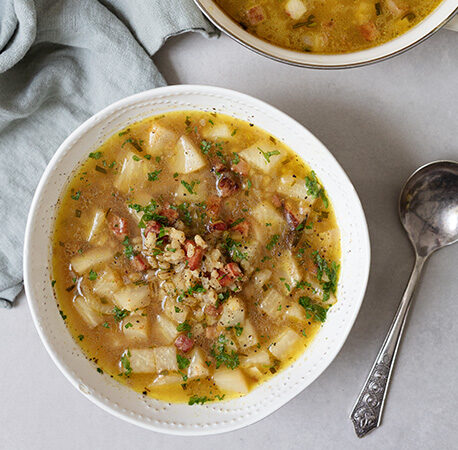Danielle Conaty from St.Clare’s Comprehensive School, Manorhamilton, Co.Leitrim, shares tips and tricks for making the ultimate comfort food.
Our small emerald isle is a country built on the foundations of a great culinary heritage. Ireland has access to the finest raw ingredients, and places great value on traditional farming methods and the demand of consumers for local produce. Irish cooks rely upon the quality of their ingredients and trusted techniques to ensure their dishes are truly delicious. Flying the Irish cookery flag at a national and international level are chefs such as Neven Maguire, Donal Skeehan, Derry Clarke, Clodagh McKenna and Rachel Allen to name but a few.
What makes a stew?
A stew is made by slow cooking cuts of meat from the hardest working parts of the animal, with some liquid (water, stock, wine or a mixture of all three) and vegetables, at a low temperature.
A penny-pinching meal
Use cheaper cuts of meat like neck, leg and shin or chicken thighs and legs, oxtail, livers or kidneys – you’ll achieve more flavour if you give them time in the oven. Depending of your preferences, rabbit, pheasant and Italian sausages all make for an even stronger taste.

Flavour enhancing tips
Add the vegetables towards the end of the cooking time, when the meat is nearly tender, so that they don’t collapse into mush — they’re nicer when they retain their shape. Alternatively, root vegetables can be roasted first to help them keep body and take on a sweet flavour. Celeriac, swede and squash take on wonderful flavour when coated and roasted with herbs and spices.
Tip – Avoid adding cabbage or broccoli to a stew; they don’t add a good flavour or a desirable texture.
Fillers and bulkers
Grains like pearl barley, rice and bashed-up pasta give extra body to a stew, while beans and lentils will add extra protein and help to keep you fuller for longer. Potatoes are a cheap and easy way to bulk up a stew — they act like a sponge and soak up cooking liquid.

Global twist
You can make a stew with beef, lamb or pork and — depending on the herbs and spices you introduce — create a range of dishes that reflect not just traditional Irish cooking, but a gastronomic tour of the entire globe.
To thicken a sauce – There’s nothing sadder than a thin stew. Here are a few things you can do to get that gorgeous rich texture and speed up the cooking time!
- If you’re browning meat or frying onions, coat them in seasoned flour first.
- If you’re making a spicy stew, add a spoon of smooth peanut butter to the stew — it thickens slightly and adds a depth of flavour.
- If you need to thicken the sauce later on in the recipe, ensure you mix a spoon of flour with a little stock to make a paste and stir gradually into the stew.

Finishing touches
- Serve with colcannon.
- Dumplings are a great addition to a hearty winter stew.
- Herby breadcrumbs or croutons add a lovely crunchy texture.
- A flavoured chilli oil or pesto works well with a light chicken or fish stew (chowder).
- Simply top with a few chopped fresh herb leaves.
Hungry for more? Check out our favourite cosy and comforting recipes, here.
- summer events
- small business
- gut health
- OATLY
- healthy
- Crudo
- top tips
- All Together Now
- fridge cake
- Events Waterford
- food festival
- Events Ireland
- me auld flower
- news
- dublin
- events Dublin
- dublin festival
- Home-Cooking
- food and drink festival
- online cooking course
- festival line-up
- cooking
- Summer festival
- eco-friendly
- Events
- cosy
- Festivals Ireland
- wine
- Body & Soul
- grapes
- music festival
- south africa






You have to be signed in to comment this post.